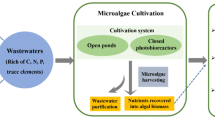Abstract
Objective
Desalination of cheese whey by electrodialysis yields saline wastewater (SWW). The goal was to test this as the basis of a culture medium and to prove experimentally the concept that it was a suitable resource for heterotrophic cultivation of the freshwater green microalga Chlorella vulgaris.
Results
Optimization of glucose concentration, nitrogen source and medium salinity for microalgal growth was first carried out in defined medium (DM) and shake flasks. These results were then adopted in shake flask cultivation experiments using pre-treated SWW medium (PSWW). Subsequently, microalgal growth under optimized conditions was tested in bioreactors. Various media such as DM, PSWW and diluted PSWW (DPSWW) were compared. Volumetric biomass productivities decreased in the order DM (0.371 g L−1 h−1, urea) > DPSWW (0.315 g L−1 h−1, soy peptone) > PSWW (0.152 g L−1 h−1, soy peptone). Although biomass productivities in DPSWW and PSWW media were significantly lower than in DM, these media required the addition of only 66 and 33% of DM N sources, respectively. No other added DM component was necessary in (D)PSWW to achieve microalgal growth.
Conclusions
Although the optimized cultivation of freshwater microalgae on alternative medium based on SWW resulted in biomass productivities lower than those on DM, the required addition of N sources was also lower. Potentially lower production costs of Chlorella biomass and the meaningful use of SWW are the main outcomes of this work.



Similar content being viewed by others
References
Bohutskyi P, Kula T, Kessler BA et al (2014) Mixed trophic state production process for microalgal biomass with high lipid content for generating biodiesel and biogas. Bioenergy Res 7:1174–1185
Bumbak F, Cook S, Zachleder V et al (2011) Best practices in heterotrophic high-cell-density microalgal processes: achievements, potential and possible limitations. Appl Microbiol Biotechnol 91:31–46
Chew KW, Chia SR, Show PL et al (2018) Effects of water culture medium, cultivation systems and growth modes for microalgae cultivation: a review. J Taiwan Inst Chem Eng 91:332–344
Choi YK, Jang HM, Kan E (2018) Microalgal biomass and lipid production on dairy effluent using a novel microalga, Chlorella sp. isolated from dairy wastewater. Biotechnol Bioprocess Eng 23:333–340
Diblíková L, Čurda L, Kinčl J (2013) The effect of dry matter and salt addition on cheese whey demineralisation. Int Dairy J 31:29–33
Doucha J, Lívanský K (2012) Production of high-density Chlorella culture grown in fermenters. J Appl Phycol 24:35–43
European Whey Processors Association. Economic report 2017/18. http://ewpa.euromilk.org/fileadmin/user_upload/Public_Documents/Facts_and_Figures/EDA_Economic_Report_2017.pdf. Accessed 14 Sept 2019
Gernigon G, Schuck P, Jeantet R, Burling H (2011) Encyclopedia of dairy sciences, 2nd edn. Elsevier, London
Humhal T, Kastanek P, Jezkova Z et al (2017) Use of saline waste water from demineralization of cheese whey for cultivation of Schizochytrium limacinum PA-968 and Japonochytrium marinum AN-4. Bioprocess Biosyst Eng 40:395–402
Li K, Liu Q, Fang F et al (2019) Microalgae-based wastewater treatment for nutrients recovery: a review. Bioresour Technol 291:121934
Lowrey J, Armenta RE, Brooks MS (2016) Nutrient and media recycling in heterotrophic microalgae cultures. Appl Microbiol Biotechnol 100:1061–1075
Morales-Sánchez D, Martinez-Rodriguez OA, Martinez A (2017) Heterotrophic cultivation of microalgae: production of metabolites of commercial interest. J Chem Technol Biotechnol 92:925–936
Nzayisenga JC, Eriksson K, Sellstedt A (2018) Mixotrophic and heterotrophic production of lipids and carbohydrates by a locally isolated microalga using wastewater as a growth medium. Bioresour Technol 257:260–265
Perez-Garcia O, Escalante F, De-Bashan L et al (2011) Heterotrophic cultures of microalgae: metabolism and potential products. Water Res 45:11–36
Quintero-Dallos V, García-Martínez JB, Contreras-Ropero JE et al (2019) Vinasse as a Sustainable Medium for the Production of Chlorella vulgaris UTEX 1803. Water 11:1526
Rader RA, Langer ES (2018) Worldwide biopharmaceutical manufacturing capacity analysis: growth continues across the board. https://bioprocessintl.com/business/economics/worldwide-biopharmaceutical-manufacturing-capacity-analysis-growth-continues-across-the-board/. Accessed 28 Sept 2019
Wang SK, Wang X, Miao J et al (2018) Tofu whey wastewater is a promising basal medium for microalgae culture. Bioresour Technol 253:79–84
Xiong W, Li X, Xiang J (2008) High-density fermentation of microalga Chlorella protothecoides in bioreactor for microbio-diesel production. Appl Microbiol Biotechnol 78:29–36
Yan D, Lu Y, Chen Y-F, Wu Q (2011) Waste molasses alone displaces glucose-based medium for microalgal fermentation towards cost-saving biodiesel production. Bioresour Technol 102:6487–6493
Zhang TY, Hu HY, Wu YH et al (2016) Promising solutions to solve the bottlenecks in the large-scale cultivation of microalgae for biomass/bioenergy production. Renew Sustain Energy Rev 60:1602–1614
Acknowledgements
Authors Tomáš Potočár and Djillali Ghobrini contributed equally. This research was supported by project of the Ministry of Agriculture of the Czech Republic QK1910300 and the Algerian Ministry of Higher Education and Scientific Research (Ministère de l’Enseignement Supérieur et de la Recherche Scientifique - Algérie).
Author information
Authors and Affiliations
Corresponding author
Ethics declarations
Conflict of interest
The authors declare that they have no conflict of interest.
Additional information
Publisher's Note
Springer Nature remains neutral with regard to jurisdictional claims in published maps and institutional affiliations.
Rights and permissions
About this article
Cite this article
Ghobrini, D., Potocar, T., Smolova, J. et al. Heterotrophic cultivation of Chlorella vulgaris using saline waste water from the demineralization of cheese whey. Biotechnol Lett 42, 209–217 (2020). https://doi.org/10.1007/s10529-019-02770-7
Received:
Accepted:
Published:
Issue Date:
DOI: https://doi.org/10.1007/s10529-019-02770-7




